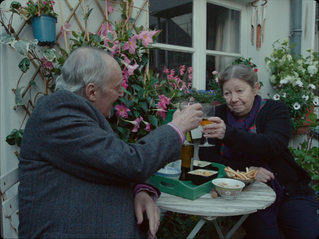Babette's Feast
- Isobel Wise
- Jun 14, 2021
- 2 min read
Gabriel Axel, 1987

Babette, the former chef of Cafe Anglais, shivers upon a doorstep in Jutland having fled Paris following its besiegement. 1871—aptly christened l’année terrible by Victor Hugo—is transforming the streets of the capital into those of gloom and conflict. Babette has come to Denmark seeking refuge, hoping to be employed by two elderly sisters with whom her friend had contact some 35 years prior. The sisters take her in as their housekeeper.
Bookended by the Franco-Prussian War and Paris Commune, today the Siege of Paris is perhaps most famously remembered for its crisis of food. Ignoring the real starvation felt keenly by Parisians, siege-time prints detail farcical menus of alligator, shoe and elephant trunk. Aperitifs of antiseptic and plates of stuffed horse-head are advertised, and to curb the most audacious of appetites, slices of spaniel meat (alongside the more flavourful poodle) grace window displays. When Babette decides to spend her lottery winnings on a feast for the sisters and village parishioners, one wonders if their reticence stems from a fear of similar gastronomic experimentations.
Babette’s Feast is as much an exploration of spiritual appetite as it is bodily. Jutland is marked by a frugality that seems topographically ingrained; the windswept coastline lacks the ostentation necessary to describe it as beautiful. Instead, like its inhabitants, it pronounces itself as humble. Those that live there do so within their means. Their houses are small and modestly furnished. They meet in the church to pray and sing together, their conversations typified by reference to God. Collectively they live on a diet of piety and boiled ale bread, renouncing all luxurious and sinful earthly pleasures that may tempt them.
Yet at dinner, Babette indulges the fervent with turtle soup served with dark Amontillado sherry; the caviar and sour cream of Blinis Demidoff; glasses of Clos de Vougeot Pinot Noir and vintage champagne; baked quail wrapped in puff pastry with foie gras and truffle jus; crunchy endive salad; slices of sponge cake oozing with rum syrup; candied cherries; hunks of cheese, pineapple, papaya, grapes; fresh figs and dates; all finished with sweet dessert wine, coffee and cognac.
For the parishioners presented with the feast, their reaction to such lavishness—all seven courses of it—falls between a desire to savour each delicacy (involuntarily) and uphold their asceticism (stubbornly). Over the course of the meal, grievances are aired and the community is brought closer. Babette’s feast proves as one of both body and soul, providing the diners and audience alike with delectable food for thought.









Comments